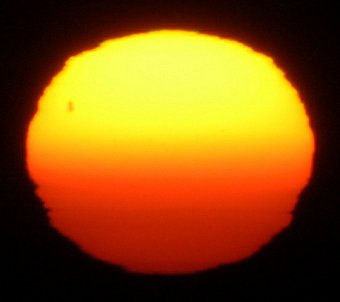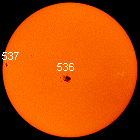
Your Authority In All Things Supernatural Since 1999
| Forum | Home | Northern California in the News | News | Y2K | Links | Sightings and Abductions | Fiction | |Shop | Interactive | About Us | Contact Us

Your Authority In All Things Supernatural Since 1999
|
|
|
|
Headlines: 01.08.04:
January 05: NASA's Mars rover Spirit has landed just where scientists hoped it would go: inside Gusev Crater, in a vast flatland perfect for roving.My hat is off to the navigation team because they did a fantastic job of getting us right where we wanted to be," says Steve Squyres of Cornell University, principal investigator for the science payload. "We hit the sweet spot. We wanted someplace where the wind had cleared [the dust] off the rocks for us--and this is it."
The region around Spirit's landing site appears to be criss-crossed by the trails of dust devils, which have carried away dust and left gravel behind. Dust-free rocks are good, because they're easier for the rover's geology instruments to penetrate and analyze.
Spirit parachuted into Gusev Crater on January 4th at midnight Eastern Standard Time. Mission planners chose to land there because, from orbit, the crater appears to be a dried up lake bed. If, indeed, it was filled with liquid water long ago, then it might have been a habitat for ancient martian life.
To the delight of researchers, Spirit's first pictures of its surroundings resemble dried up lake beds on Earth. The terrain is flat and peppered with small rocks. No one knows if the resemblance is more than superficial. Spirit will use its geology tools to find out.

"What we're seeing is a surface that is remarkably devoid of big boulders, at least in our immediate vicinity, and that's good news because big boulders are something we would have trouble driving over," Squyres said. "We see a rock population that is different from anything we've seen elsewhere on Mars, and it comes out very much in our favor." The flatland is well suited for roving.
At the moment, the rover remains perched on its lander platform, and the next nine days or more will be spent preparing for egress, or rolling off, onto the martian surface. The platform is tilted by only two degrees, and the front deck is only about 37 cm off the ground. With no large rocks blocking the way, the rover is in good position for egress. The rover's initial images have excited scientists about the prospects of exploring the region after the roll-off. "This is our new neighborhood," says Squyres. And for the next three months, if all goes well, Spirit will explore it, searching the rocks and soil for clues to the mystery of Mars water, and maybe, martian life.
Spirit's twin Mars Exploration Rover, Opportunity, will reach its landing site on the opposite side of Mars on Jan. 25th to begin a similar examination of a site called Meridiani Planum. Stay tuned for more about that in the weeks ahead!!!
The World in a Grain of Stardust
Philosophers have long sought to "see a world in a grain of sand," as William Blake famously put it. Now scientists are attempting to see the solar system in a grain of dust--comet dust, that is.
If successful, NASA's Stardust probe will be the first ever to carry matter from a comet back to Earth for examination by scientists. It would also be the first time that any material has been deliberately returned to Earth from deep space.
And one wouldn't merely wax poetic to say that in those tiny grains of comet dust, one could find clues to the origin of our world and perhaps to the beginning of life itself.
Comets are like frozen time capsules from the time when our solar system formed. Drifting in the cold outer solar system for billions of years, these asteroid-sized "dirty snowballs" have undergone little change relative to the more dynamic planets. Looking at comets is a bit like studying the bowl of leftover batter to understand how a wedding cake came to be.
Indeed, evidence suggests that comets may have played a role in the emergence of life on our planet. The steady bombardment of the young Earth by icy comets over millions of years brought some of the water that makes our brown planet blue. And comets contain complex carbon compounds that might be the building blocks for life.
After the encounter, Stardust will loop around the Sun on a two-year journey back to Earth. In January 2006, home again, the spacecraft will eject the Sample Return Capsule (SRC), which looks like a miniature Apollo capsule. The SRC will parachute to Earth and, if all goes as planned, land in Utah where scientists will be waiting?
To see a world in a grain of sand
And a heaven in a wild flower
Hold infinity in the palm of your hand
And eternity in an hour
William Blake (from Auguries of Innocence, c.1800)

BIG SUNSPOT: Sunspot 536 is big, about six times wider than Earth. Astronomers call this a "naked-eye" sunspot because you can see it without a telescope--but beware. Staring at the sun can damage your eyes. Lately, solar activity has sparked the interest of both the scientific and military community. Recent solar flares and solar storms have damages many satelites orbiting our planet and even halted communications around the globe for moments for hours. Why is the sun becoming so volatile? As you all know from basic study of stars; a star ages just like humans. Starting off as a blue dwarf, and in the end becoming a White dwarf and then exploding in to cosmic dusts in its death. White dwarfs project more radiation and more heat. Theorettically, Earth would not survive if the Sun changed to a white dwarf. All plant life and humans would not be able to survive the severe heat and radiation entering the atmosphere.

DUST ACTIVITY ON MARS: Mars has been receding from Earth and fading since
last August. This week, though, the red planet has gotten a smidgen
brighter. The reason: a dust storm is brewing. Bright dust clouds on Mars,
reflecting sunlight more than the underlying terrain have boosted the
planet's total brightness by about 0.17 magnitudes.
Amateur astronomers using 12 to 16 inch telescopes have been tracking the
dust clouds responsible for this change. You can see their pictures on
spaceweather.com. So far the dust storm is a regional one; it spans only a
fraction of a martian hemisphere. Sometimes such clouds grow to encircle
all of Mars, but that hasn't happened in this case--at least not yet.
On 8 Jan 2004 there were 564 known Potentially
Hazardous Asteroids
2003 YS17
Jan 14
14 Lunar Miles away
2001 BE10
Jan 15
23 Lunar Miles
SPACE WEATHER
Current Conditions

Solar Wind
speed:593.7 km/s
density: 2.2 protons/cm3
Updated: Today at 1125 UT
X-ray Solar Flares
6-hr max:C3
24-hr: M1
Updated: Today at 0505 UT

Every day, somebody experiences something supernatural. Perhaps you have, too. Whether you have or not, this is the place for you. Be it UFO's, crop circles, abductions, or other unexplainable phenomena, you are welcome here.
People around the globe are taking notice. How long will they stay quiet? This is a place for sharing your experiences and memories. Feel free to take a look around. Everyone is welcome to share their stories with us, and we will publish them here at your request. Contact [email protected] for information on how to submit your stories, whether they are fact or fiction.
Click to Vote!
![]()
© 1999-2004 I've Been Probed Anonymous.
Contact [email protected] for
information.
![]()